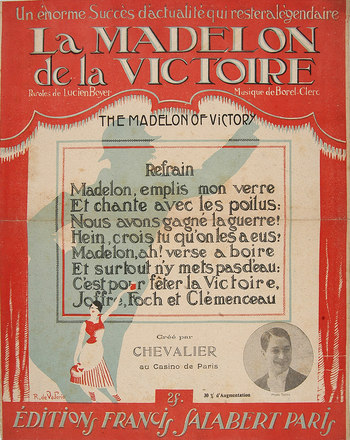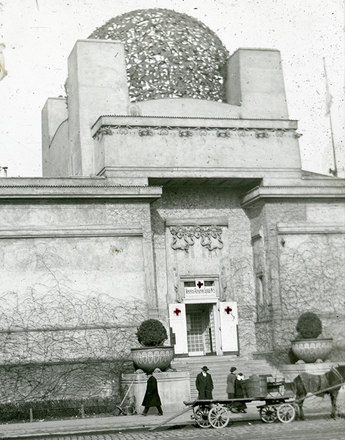‘La Victoire en chantant’ – The French chanson in the First World War
“Il suffit d’ajouter ‚militaire’ à un mot pour lui faire perdre sa signification. Ainsi la justice militaire n’est pas la justice, la musique militaire n’est pas la musique.“ (Georges Clemenceau)
(It is enough to add ‘military’ to a word for it to lose its meaning. Hence military justice is not justice, military music is not music.)
Musical life in the other belligerent states was hardly different from that in Austria-Hungary or Germany. There too folk songs were turned into battle songs and the vast majority of musicians placed themselves at the service of the patriotic cause.
In France the wartime mood found expression above all in the popular genre of the chanson, whose strongly marked concentration on the lyrics made it particularly suited to convey moods and messages. Whereas initially these lyrics were characterized by optimism and fighting spirit, in the course of the war it was the elements of entertainment and distraction as well as the joy of homecoming after the achievement of victory that became relevant.
La Madelon was appeared in 1914 just before the beginning of the war and became a veritable hit during the war itself. The chanson tells of Madelon, a loose-living barmaid who steals the hearts of soldiers by the dozen. She turns down any proposal of marriage, because, as she sings, ‘Why should I take just one man when I can love an entire regiment?’ La Madelon was translated and also became a soldiers’ song in England and Spain. In 1939 Marlene Dietrich sang the chanson in Paris on the French National Day, and during the Nazi occupation the melody, with a variety of lyrics, became a song of resistance.
Ma p’tite Mimi was written by Théodore Botrel, who had made a name for himself in Paris as a cabaret artist even before the beginning of the war. The government sent him to the front to provide programmes of entertainment for soldiers. In 1915 Botrel wrote a love song to ‘his little Mimi’, whose birdlike singing, ‘Taratara, taratara, taratatère’, enchants him, so that he loves her above all else. Mimi, as he lovingly calls his machine gun, accompanies the soldier throughout his life in the war, so that he swears eternal loyalty to her: ‘Jusqu'au bout, restons unis, Pour le salut du pays.’ (Let us stay united right to the end, For the good of the country.) At the end of the war, after the last salvo, the gun is wistfully sung to sleep as a farewell: ‘Et tes pleurs mouilleront mes yeux, En te faisant mes adieux.’ (And your tears will moisten my eyes, When I say farewell to you.)
After the French army was defeated in the Chemins des Dames and Craonne districts around the towns of Laon, Soissons und Reims in the north of France in one of the bloodiest battles that took place on French territory, one of the most popular anti-war songs, the Chanson de Craonne, was composed. It was a product not just of the defeat but also of mutinies and their suppression in the French army. The lyrics are by an anonymous author, while the melody was borrowed from a hit from the year 1913. This chanson was immediately banned (and remained so until 1974) because it was argued that it offended the honour of the army and war veterans.
Translation: Leigh Bailey
Bouzard, Thierry: Le chant militaire français: un patrimoine vivant, in: Revue historique des armées, 242/2006, 98-113. Unter: http://rha.revues.org/3982 (20.06.2014)
Chauveau, Philippe: Une histoire de la chanson française, Paris 2009
Tonaufnahme "La Madelon". Unter: https://www.youtube.com/watch?v=pZPoAvKSWG0 (20.06.2014)
Text: http://fr.wikipedia.org/wiki/La_Madelon (20.06.2014)
Tonaufnahme "Ma p’tite Mimi". Unter: https://www.youtube.com/watch?v=B9hjGeVpsoU (20.06.2014)
Text: http://www.dutempsdescerisesauxfeuillesmortes.net/paroles/ma_mitrailleus... (20.06.2014)
Tonaufnahme "Chanson de Craonne". Unter: https://www.youtube.com/watch?v=z-yRaEYQNQs (20.06.2014)
Text auf Deutsch: http://de.wikipedia.org/wiki/Chanson_de_Craonne (20.06.2014)
-
Chapters
- ‘Long jackets instead of Tailcoats’ – The Music Business in Times of Austerity
- Arousing Patriotic Sentiments in the Concert of Nations
- ‘In War the Muses Learn How to Serve’
- Serious Times – Serious Art
- ‘I’d like to dance, I’d like to shout for joy’ – Popular Music in the First World War
- ‘German Musical Life and How to Delouse It’ – Music for Use in the War
- ‘What the soldier in battle dress is singing now will be sung by the entire German people in rare unity.’ – Soldiers’ Songs as Collectors’ Items
- ‘It’s Hugo’s damned duty not to die for the fatherland before I’ve got my Act III.’ – Richard Strauss and the First World War
- Militarism and Terror Set to Music
- ‘La Victoire en chantant’ – The French chanson in the First World War
- Musical Innovations in the First World War
- Composers’ Fates: War, Death and the Longing for Peace and Overcoming Memories
- Star Composers and the Great War



